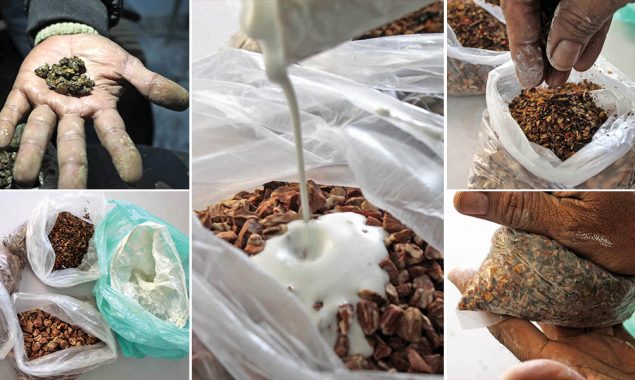Synopsis
A high number of lip and oral cavity cancer cases in Karachi are reported due to the easy availability of substandard, cheap tobacco products

athar khan/Bol News
KARACHI: During 2010-2019, 22,858 cases of cancer were indexed at the Dow Cancer Registry, Bol News has learnt. Of these, 4,400 were diagnosed as lip and oral cavity cancer which was the most common malignancy in males and the second most common in females.
However, circumstantial evidence suggests that the true number of oral cancer cases in the metropolis linked to the consumption of cheap, substandard tobacco products may be much higher than these numbers depict. After all, the consumption of hazardous products like gutka is widespread in the city, especially in lower-income groups.
Oral cancers are part of a group of cancers commonly referred to as head and neck cancers.
According to Globocan 2020, every 14 persons in 100,000 were diagnosed with either lip or oral cancer in the past five years. A study was conducted at the Dow Cancer Registry (DCR) of the Dow University of Health Sciences (DUHS) to estimate the cancer incidence by age group and gender for the population of Karachi Division by analysing the Karachi Cancer Registry data of 2017-19, which revealed that lip and oral cavity cancer is highest in Karachi.
Another study was undertaken at DCR to investigate frequencies and age-standardised-rates (ASR). The data from study were compared with the ASR of lip and oral cavity cancer from selected Asian countries and reported an alarmingly high ASR of lip and oral cavity cancer in Karachi as compared to Pakistan as a whole and other Asian countries.
Alarming rate
A plausible explanation for the higher burden of oral cancer in Karachi is the very high consumption of tobacco products compared to any other part of Pakistan. The risk of developing head and neck cancer increases 10 times among habitual tobacco users than non-users.
The various forms of tobacco used in Karachi are smoking, such as cigarettes, bidi, shisha and the use of smokeless tobacco (naswar and gutka) is particularly high compared to other parts of the country.
Both are chewed and kept in the mouth for long periods of time resulting in increased contact time of chemicals with buccal mucosa (inner cheeks) leading to chronic inflammation and thus a higher probability of oral cancer.
In addition to this, problems were caused by chewing smokeless tobacco like paan, gutka and supari which contained highly carcinogenic products such as betel-nuts or naswar (powdered moist tobacco) which is kept in the base of oral cavity or alongside teeth between the cheek and mandible for a long time. Gutka is a mixture of paraffin wax, areca nuts, catechu, lime and tobacco.
This pre-disposes our population to oral cancer. Moreover, animal blood is reportedly used in the making of gutka, commonly called ‘mawa’ among its users.
A regional issue?
Areas and cultures also affect the causes of cancer. As per Globocan, in China lung cancer is the most common malignancy while the rate of prostate cancer in men is highest in the United States and Japan. In Saudi Arabia and the United Arab Emirates, colorectal cancer is the most prevailing cancer.
The cause of cancer is mostly associated with the living and eating habits of a particular area and to its culture. Likewise India and Pakistan have higher rates of oral cancer in men due to increased smoking and consumption of betel nuts. Study at DCR also reveals the observation that males, particularly those with a lower socioeconomic status, consume more tobacco products in Karachi. It is reportedly cheaper and easily available to them and socially acceptable.
Seeking help
Historically, the death rate associated with this cancer is particularly high not because it is hard to discover or diagnose the disease but due to the cancer being routinely discovered late in its development.
Dr Najeebullah, a senior doctor at Sindh Institute of Urology and Transplantation (SIUT) and Shaukat Khanum Memorial Cancer Hospital and Research Centre (SKMCH&RC) said, “The real threat is that this cancer may go unnoticed in its early stages. It can be painless but any physical changes may be obvious. So never ignore an ulcer in your mouth that will not heal. Any pain or discomfort in your mouth or unusual symptoms that last more than two weeks should not be ignored and one must see a doctor.”
Mitigation
While shedding light on the causes of oral cancer, Dr Najeebullah stressed on the fact that many reported cases of oral cancer have chronic history of usage of tobacco whether smoking or smokeless tobacco such as paan, gutka and naswar. “In 2004, the World Health Organisation (WHO) deemed betel nut by itself carcinogenic. Around 85 to 90 per cent oral cancer cases may dip if tobacco in any form is banned.”
Though the Covid-19 pandemic has caused an increase in prices of numerous items, the prices of cigarettes could not be increased during the past three years, the expert observed. “On the one hand, we have been spending Rs615 billion on treatment of tobacco-related diseases. On the other hand, tax, which is considered the only option to discourage smoking, could not be increased. I urge the government to reconsider its policies,” stated Muhammad Kashif Mirza, an anti-tobacco activist.
One thing is clear after studying the research that further spread of this deadly disease can be prevented. Lip and oral cavity cancer is largely preventable if relevant legislation was made and implemented in Pakistan to ban the use of tobacco products.
The authorities concerned should allocate an appropriate healthcare budget for the diagnosis and treatment of lip and oral cavity cancer so that this highly common malignancy can be mitigated.
Read More News On
Catch all the Pakistan News, Breaking News Event and Latest News Updates on The BOL News
Download The BOL News App to get the Daily News Update & Follow us on Google News.




